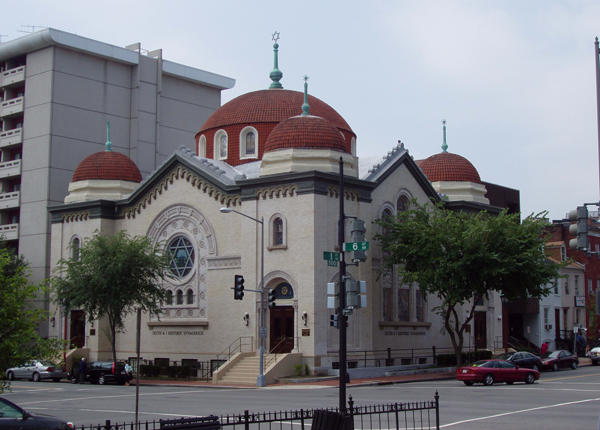(RNS) — The custodians in my synagogue are still cleaning up from the High Holy Days — putting the extra chairs back into storage, putting the machzorim (the prayer books for the Days of Awe) back into their boxes, and getting our “regular,” non-white Torah covers out of the closet.
What now?
What is the real state of American Judaism?
I turn to the new book by the prominent American Jewish sociologist, Professor Jack Wertheimer — The New American Judaism: How Jews Practice Their Religion Today. (Full disclosure: Professor Wertheimer is a friend, which has never prevented either one of us from agreeably disagreeing with each other).
Professor Wertheimer sought to discover how American Jews practice Judaism today — as a religious expression. He looked at various surveys, especially the famous Pew survey. He conducted interviews, lasting an hour or more, with over 160 rabbis, of all types and in every region of the United States. (Again, full disclosure: I was one of them).
Wertheimer does an excellent job of taking a religious tour of modern American Judaism. How are the various American Jewish movements doing — not based on any external standard, but based on the standards that they themselves have established?
For example, he cites the Pew study:
- “Jews exhibit lower levels of religious commitment than the U.S. general public, among whom 56% say religion is very important in their lives and an additional 23% say it is somewhat important.” The comparative figures for Jews are 26 percent (very important) and 29 percent (somewhat important.)
- “Belief in God is much more common among the general public than among Jews. Even among Jews by religion, belief in God is less common than among members of other major U.S. religious groups.”
- “Jews report attending religious services at much lower rates than do other religious groups. Six-in-ten Christians (62 percent) say they attend religious services at least once or twice a month (compared with 29 percent of Jews by religion).”
No, you will protest: in our community, it is different. We have creative programming. Our services are great. We have wonderful social justice programs.
I believe you.
But, if we look at the broader picture of non-Orthodox Judaism in this country, Wertheimer concludes: Despite the best attempts of synagogues and their movements, despite creative programming and innovations in worship, American Judaism is in a recession.
Even, despite the throngs on the Days of Awe: To quote Wertheimer:
When an individual engages in public worship just a few days each year, what sense does the entire exercise make? Public prayer is a discipline, requiring training and practice; it does not work as a sometime thing…at a time when a therapeutic worldview, what are synagogue-goers to make of a liturgy that refers explicitly to sin, a category that is anathema to the mental health profession?
The greatest gift of Wertheimer’s book? He is a sociologist — and as such, he puts his findings into a larger American context.
American Jews have assimilated.
It is not that American Jews would rather become WASPs so that we can get into the country club.
That’s not even a thing anymore. Assimilation – as a way of fitting into America – is the eight-track stereo of Jewish ideologies. It is simply obsolete.
I mean that American culture has forced us to assimilate – to absorb – un-Jewish ways of thinking about life.
- I am an individual. I do not need community.
- I can buy whatever I want and whatever I need – whenever I want it. What I cannot buy, I can rent.
- I only measure something by how good it makes me feel – at the moment.
I believe that those ideas represent the single greatest challenge to Judaism since the Enlightenment and the Emancipation from the European ghettos. They are beyond overwhelming.
Wertheimer quotes Rabbi Sharon Brous. She asks the questions that haunt me:
How does a culture of narcissism, over-entitlement and personalization become Jewish communal engagement?
How can the IPhone generation find rigorous exploration of Talmud and Jewish literature to be compelling and life-sustaining?
How do we cultivate a sense of obligation, enchantment, spiritual hunger in a generation that can log off or sign out in every other aspect of life?
What is amazing to me is how many of affiliated Jews have become cultural warriors. They have tried to create a larger, thicker American Judaism.
On Yom Kippur, Jews recited sins in alphabetical order.
I invited my congregation to hear our collective path out of sin in alphabetical order.
We need a Judaism that will embody:
- Aspiration
- Boldness
- Compassion
- Depth
- Empathy
- Faith
- Generosity
- History
- Inspiration
- Justice
- Kindness to each other
- Learning
- Making the world whole
- No to the wrong things
- Opening doors to all kinds of Jews
- Prayerfullness
- Questing for the holy
- Rituals with depth
- Spirituality
- Tikkun olam
- Universal world view
- Values
- Women’s equality
- Xpectations
- Yes to the right things
- Zeal for the right causes
Will those items heal the sociologist context in which we now find ourselves?
Overturn? No. Mitigate? Yes.
But — and this is a large “but” — it cannot only be the Orthodox who will step forward and create a new and renewable American Judaism. It will take a thickness of culture and of engagement.
More than this, going back to the late Fred Rogers: it will take an American Judaism that functions like a neighborhood, in which we feel a sense of obligation and connection to each other.
Wertheimer would want that. So would I.
And so, I suspect, would you.






